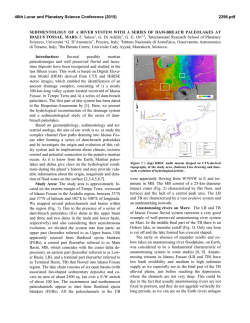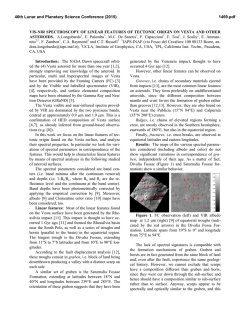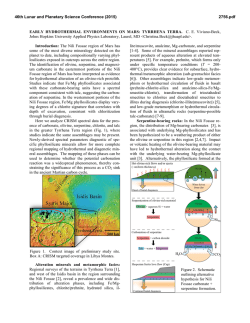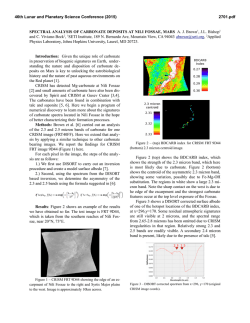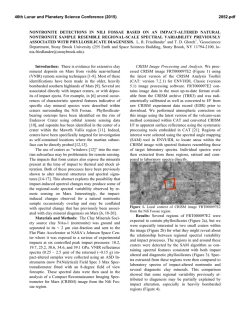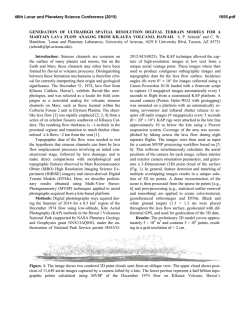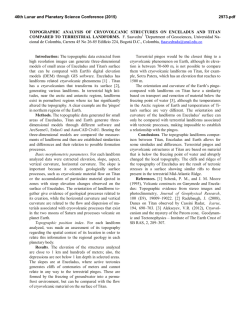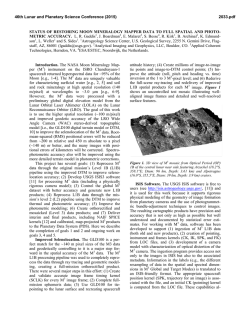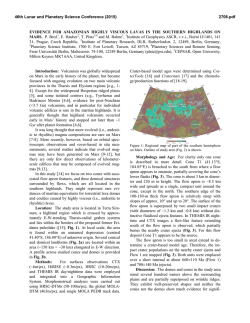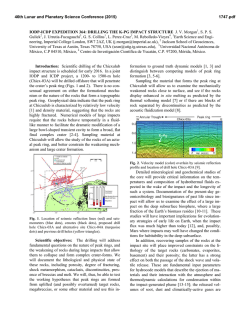
of the Cerberus Fossae, Mars: Evacuated Dikes - USRA
46th Lunar and Planetary Science Conference (2015) 2367.pdf UNRAVELING THE FORMATION MECHANISM(S) OF THE CERBERUS FOSSAE, MARS: EVACUATED DIKES, GRABEN, OR BOTH? Amanda L. Nahm1, Simon A. Kattenhorn2, and Matthew W. Pendleton1, 1Department of Geological Sciences, University of Idaho, Moscow, ID 83844, [email protected]; [email protected], 2ConocoPhillips Company, 600 N. Dairy Ashford, Houston, TX 77079, [email protected]. Introduction: The Cerberus Fossae (CF) region on Mars (6–12ºN, 154–174ºE) is located SE of Elysium Mons (Fig. 1) and is dominated by four sets of SE-trending fractures which extend ~1200 km (Fig. 1). The fracture sets are spaced ~40–45 km apart and are highly segmented. Relative to other geological features in the area, the CF fractures are young, as they cut most other features (craters, knobs of higher topography, etc.) along their lengths. Crater counting gives an age of the lavas that are cut by CF of ~100– 200 Ma [e.g., 1] thus giving a maximum age for the observable fossae in the CF. Hypothesized formation mechanisms: Previous work has proposed that these fossae are the surface expression of magmatic dikes that extend radially from Elysium Mons [e.g., 2], especially as they appear to act as the source region for at least two Late Amazonian megaflood channels (Athabasca and Grjotà Valles). These floods have been interpreted as either the result of magma-induced melting of the cryosphere [1, 3, 4] or outflow of water from a breached aquifer [5, 6] above an intruding dike beneath the fossae. Extensive lava flows emanate from the Cerberus Fossae (CF) fissures [6–8], providing support for this hypothesis. Figure 1. Regional setting of the Cerberus Fossae. Colored Mars Orbiter Laser Altimeter (MOLA) topography (128 ppd) overlain on hillshade. CF fissures mapped in white. Place names labeled for reference. However, other past work suggests that the surface manifestation of the CF fissures is the result of normal faulting, creating graben [4, 9, 10], and that faulting and fossae collapse postdate flooding and volcanism [e.g., 1, 5, 9]. Some studies [e.g., 4, 6, 11] have also concluded that the graben may have formed as a result of intrusion of underlying dikes. Thus, while significant aspects of the volcanic and fluvial history are well documented, the primary mechanism(s) for the formation of the fossae are not well understood. As one of the youngest tectonically modified regions on Mars, CF is fundamentally important to understanding the interaction between volcano-tectonic processes and the near-surface cryosphere on Mars. Therefore, the primary goal of this work is to determine whether the fossae are graben, evacuated magmatic fissures (dikes), or ice meltrelated depressions through analysis of cross-strike topography. Figure 2. Comparison of the characteristic topography (vertical displacement) for dike-induced topography (a) and tectonic graben (b) in cross-section. (a) Model parameters for the hypothetical dike shown here: 10-km high, 40-km long, rectangular vertical dike with upper tip at 5 km depth and dike inflation of 1 m. (b) Model parameters for a hypothetical graben shown here: 40-km-long, graben-bounding normal faults spaced 4 km apart, dipping at 60º, lower fault-tip depth of 3.8 km (so they do not intersect), and cumulative slip of 100 m. In addition to the different morphologies, note the drastically different vertical scales [(a) dike in centimeters versus (b) fault in meters]. Results calculated at the surface from Coulomb program. Comparison of dike and graben topography: Graben produced by purely tectonic stresses (i.e., without subsurface dike intrusion) can be distinguished from dike-induced deformation by the detection of their subtle yet diagnostic topographic signature [e.g., 12–15]. For example, the surface topography produced by slip along two inwardly dipping normal faults (i.e., graben) is elevated and concaveup in the footwall [12, 16, 17] and decays more rapidly with distance from the fault (Fig. 2b) than the topographic swells characteristic of dike inflation in the subsurface (Fig. 2a) [e.g., 12]. During dike inflation, the rock on either side of a vertical dike is displaced symmetrically outward and upward, forming characteristic topographic swells [12] (Fig. 2a). Normal faults may then nucleate at the crests of the topographic swells and propagate downward, forming a structural graben above the dike [e.g., 12–14, 18], and the width of the graben scales with the depth to the top of the dike [e.g., 12–15, 17, 19]. 46th Lunar and Planetary Science Conference (2015) Data: In order to use topography to distinguish between these end-member formation mechanisms, we utilize existing High Resolution Stereoscopic Camera (HRSC) Digital Elevation Models (DEMs) [20, 21] archived at http://hrscview.fu-berlin.de available for the CF region. Clustered topographic profiles were derived from the HRSC DEMs perpendicular to each fossa trace. The clustered profiles (spaced an average of 50 m apart) were averaged. Representative averaged topographic profiles (numbered 1 through 6) and corresponding locations are shown in Fig. 3. Figure 3. Representative topographic profiles for Cerberus Fossae. Upper panel: Map showing the locations of the topographic profiles (yellow lines, numbered) and the Cerberus Fossae (outlined in white). Background image: MOLA 128 pixel per degree hillshade. The heavy black line in all profiles is the average of the clustered profiles and the thin dotted lines are ±1 standard deviation. Y-axis: elevation (m); X-axis: distance along profile (km) Results and discussion: Despite the large coverage of CF by the HRSC DEMs (approximately 4050%), a total of 6 averaged profiles with potential topographic signatures were obtained, likely as a result of the pre-existing topography and subsequent modification of the fossae (see below). Based on shape and comparison with Fig. 2, potential dike signatures are seen in 1, 2, 3, and 5, while potential graben signatures may be present in profiles 1, 4, and 6 (Fig. 3). 2367.pdf This result was unanticipated given that the fossae are well preserved, extensive, and young, making the preservation of signatures more likely. As shown above, the topography encompassing the central CF is somewhat rugged and, in most cases, this likely complicates the identification of characteristic dike or graben topographic signatures. The en echelon, and often overlapping, geometry of the fossae may have contributed to the loss of or difficulty recognizing the diagnostic signatures. Many profiles and images show indications of probable late-stage (or at least post-fossae formation) modification by surface processes. Topographic profiles show asymmetry immediately adjacent to the fossa, which may be influenced by knobs of older terrain near the fossa, modification of the near-fossa area from effusion of lava or water, or collapse of the fossa walls. The scalloped, non-linear rims of the fossae also indicate that mass wasting and collapse modified the plan view shape of the fossae. Features that resemble the “collapsed fault scarps” of [22] are abundant in CF and have been interpreted elsewhere on Mars to result from widening of U-shaped troughs through landslides and retreat of unstable normal fault scarps [22]. This comparison, plus other observations, supports the idea that the Cerberus Fossae are underlain by dikes or were at some time in the recent past. For example, the effusion of large volumes of lava from the fossae necessitates that these underlying dikes reached the surface in many places. We therefore envision a scenario in which most dikes reached the surface, causing elongate depressions along them as they melted the ground ice prior to eruption [e.g., 23], erupting lava from multiple locations, and providing a source for the water for the Late Amazonian floods. Later, the dikes evacuated to form deep, narrow fissures (such as the fissure created during the 10th century Eldgjá eruption in southern central Iceland) with rounded ends. References: [1] Berman, D. C. and W. K. Hartmann (2002), Icarus, 159, 1– 17. [2] Kattenhorn, S. A. and J. A. Meyer (2010), 41st LPSC, Abstract #1271. [3] Burr et al. (2002), GRL, 29, 1–3. [4] Head et al. (2003), GRL, 30, 1577. [5] Burr et al. (2002), Icarus, 159, 53–73. [6] Plescia, J. B. (2003), Icarus, 164, 79-95. [7] Keszthelyi et al. (2000), JGR-Planets, 105, 1502715049. [8] Jaeger et al. (2007), Science, 317, 1709–1711. [9] Vetterlein, J. and G. P. Roberts (2009), JGR-Planets, 114, E07003. [10] Vetterlein and Roberts (2010), JSG, 32, 394–406. [11] Ernst et al. (2001), Ann. Rev. Earth Planet. Sci., 29, 489–534. [12] Rubin, A. M. and D. D. Pollard (1988), Geology, 16, 413–417. [13] Rubin, A. M. (1992), JGR, 97, 1839–1858. [14] Mastin, L. G. and D. D. Pollard (1988), JGR, 93, 13221–13235. [15] Schultz et al. (2004), Geology, 32, 889–892. [16] Weissel, J. K. and G. D. Karner (1989), JGR, 94, 13919–13950. [17] Schultz, R. A. and J. Lin (2001), JGR, 106, 16549–16566. [18] Schultz, R. A. (1996), JSG, 18, 1139–1149. [19] Okubo, C. H. and S. J. Martel (1998), J. Volcanol. Geotherm. Res., 86, 1– 18. [20] Gwinner et al. (2007), Proceedings of the ISPRS Working Group IV/7 Workshop, Houston, 2007. [21] Gwinner et al. (2008), LPSC XXXIX, Abstract #2373, 2008. [22] Mège et al. (2003), JGR, 108, 5044. [23] Pendleton, M. W. and S. A. Kattenhorn (2010), 44th LPSC, abstract #2525.
© Copyright 2025
